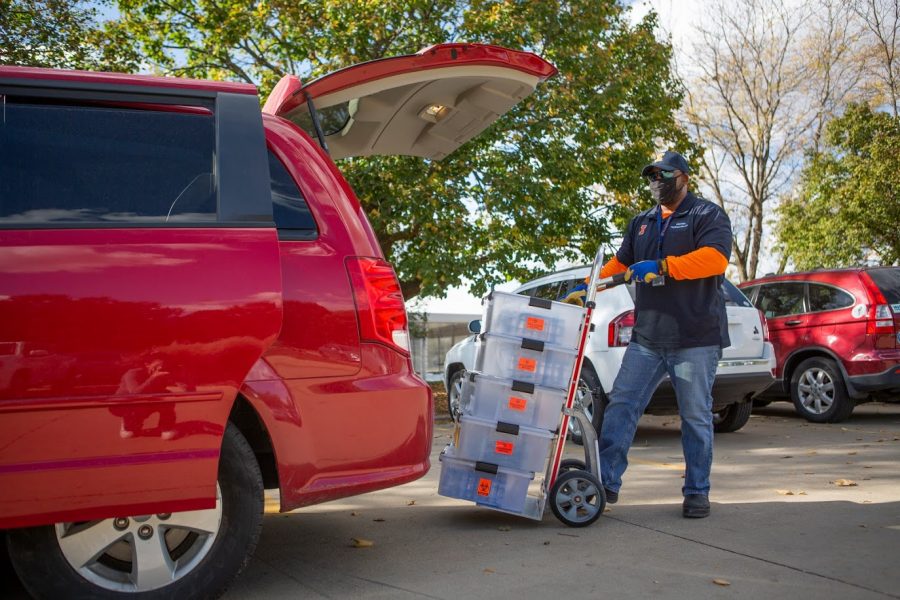“A tall order”: Inside UI’s COVID testing lab
A University worker unloads completed COVID-19 tests outside the Veterinary Medicine Basic Sciences Building on Friday. The Veterinary Diagnostics Lab staff is equipped to test about 10,000 saliva tests per day.
October 19, 2020
Every hour, vans marked “Test Delivery Vehicle” criss-cross the campus, collecting their cargo — boxes of COVID-19 test samples — from the University’s 14 testing sites. From there, they speed off toward the south of campus, where the University’s Veterinary Medicine Basic Sciences Building is tucked away.
From the exterior, it doesn’t really look that special, just another gray, concrete building on a university campus filled with many similarly brutalist structures. Yet it is here where every saliva sample collected by the University will end its journey, here in the hands of a lab technician at the University’s Veterinary Diagnostic Lab, or the VDL.
Originally designed to handle diagnostic testing for animals, the VDL has recently shifted its focus toward conducting COVID-19 tests using a method developed at the University that involves testing saliva samples via real-time polymerase chain reaction, or PCR.
While the VDL still conducts animal diagnostic testing for its clients, a section of the lab space has been set aside and reconfigured for processing COVID-19 tests. Toward the end of the hallway and past a set of recently installed glass doors, lab technicians — both veteran VDL staff and newly hired “visiting research specialists” — work around the clock labeling, scanning, pipetting and testing roughly 10,000 saliva samples a day for COVID-19.
“That’s quite a tall order for any diagnostics lab to do,” said Dr. Timothy Fan, a member of the SHIELD team and professor in Veterinary Medicine who works at the VDL.
Get The Daily Illini in your inbox!
The Testing Process
Upon delivery, the samples, which arrive in racks of 95, are taken to into a processing room where racks of saliva samples are stacked on a table in the center of the room, forming a venerable wall of plastic and saliva towering roughly half a meter above the three or four lab technicians working meticulously below.
The arriving samples are split into batches of 380 samples, or four racks. Lab technicians then individually label the sample tubes from one to 380 with a marker and scan their barcode stickers into an Excel spreadsheet.
Brianna Salgado, a technician at the lab, said the lab typically handles around 18-25 batches per day.
“Sometimes we get around eight to 10 (priority sample batches) and then an additional 10 to 15 batches,” she said.
From there, the samples are put directly into hot water baths, where they are heated for 30 minutes at 95 degrees celsius in order to deactivate any virus that might be present. Then they are cooled in ice water for another 10 minutes.
Afterward, the samples are then taken by the batch into plating rooms, where, under a biosafety cabinet, lab technicians manually pipette 100 microliters of saliva from each sample into four 95-well PCR plates containing a buffer solution. There are actually 96 wells in each plate, but one well is reserved for a control sample.
“We’ve had some people plate up to 20-some plates per shift,” said Evette Vlach, a Veterinary Research Specialist at the VDL. “That’s a lot of samples if each plate has 95 samples. That can get hard on your hand, too.”
After that, the 95-well plates are taken to a lab robot that automatically pipettes the saliva-buffer solution from the 95-well plate into a higher capacity, 380-well plate — in reality, 384 wells — containing the chemical reagents necessary to facilitate the real-time PCR used to test for the presence of COVID-19. The plate is then sealed in plastic and ready to be tested.
This sealed plate is taken to a corner room containing six QuantStudio real-time PCR machines. The sealed plate is inserted into one of the machines, which then outputs the test results that are analyzed by lab technicians.
The lab also maintains a dedicated PCR machine used for retesting. Dr. Leyi Wang, professor in Veterinary Medicine and virologist who oversees the processing of COVID-19 tests at the University, stated the VDL’s testing procedure calls for any samples that initially test positive to be tested a second time for confirmation.
“We want to be sure that we can get (the positive result) duplicated before we tell someone they tested positive,” Vlach said.
Bumps in the Road
Despite being originally designed to process about 10,000 COVID-19 samples per day, during the first few weeks of widespread testing at the University, the VDL was receiving upwards of 18,500 samples per day, which significantly strained the lab’s infrastructure and staff.
“We did it,” Vlach said. “It just wasn’t in the fashion we anticipated it would be in.”
This near-doubling of tests the VDL was expected to conduct inevitably overwhelmed the staff tasked with conducting them.
“We all probably had the same outlook of ‘this is too much’ if it’s 18,000 a day,” Vlach said. “We were all just like, ‘OK, we were doing less than this, and now we’re doing … what?’”
As the number of samples began to accumulate, the staff “took it in stride,” doing their best to process as many samples as they could. They worked longer days, and while their shifts technically last for nine hours with an hour lunch break, many technicians stayed behind after their shift to help out.
“Everybody was putting in a lot of extra effort,” Vlach said. “It had to be done. The people that were available did it.”
As samples kept coming in, the lab ran into another problem; it was running out of space. Vlach described having “major issues” storing COVID-19 samples as well as supplies in the lab, with the backlog of sample boxes reaching up to the ceiling at times.
“It was almost like ‘Hoarders’ on TV,” Vlach said. “It got to the point where you could hardly move, because so much was coming in, and we didn’t have the people to process it fast enough.”
Slight tweaks were made to the VDL’s testing process that helped ease congestion. The VDL’s director, Dr. Richard Fredrickson, arranged for an external storage trailer to be brought in so empty sample racks and sample totes could be stored outside the lab for sample delivery drivers to pick up.
“That really helped eliminate a lot of the congestion,” Vlach said. “But if we were still getting 18,000 samples a day, the congestion is only relieved so much.”
Eventually, the University changed the testing requirements for on-campus students and staff, targeting populations more likely to have been exposed. Since then, the VDL has been receiving the number of samples it was set up to handle: around 10,000 per day.
“Now that it’s at around 10,000, it’s much better,” Vlach said. “For the staffing that we have, that’s like the maximum comfort zone.”
Despite consistently processing about 10,000 tests a day for the past few weeks, Wang and Vlach maintain the VDL is understaffed.
“On certain shifts and certain days, we have just the right amount of people,” Vlach said. “There (are) other days where we have little coverage.”
Reflecting on her time at the VDL, Vlach appreciates being able to work with staff from many different walks of life and seeing them contribute to the lab.
“Even if they didn’t necessarily have a heavy scientific background, they just have a lot of common sense,” she said.
To Vlach, the testing process is “like a machine.”
“We all have a certain role,” she said. “Everyone has their position, and it runs.”
Editor’s note: A previous version of this article said a lab technician handles 18-25 batches of tests per day. It is the lab, not the technician, that may handle that many batches of tests. The Daily Illini regrets this error.







